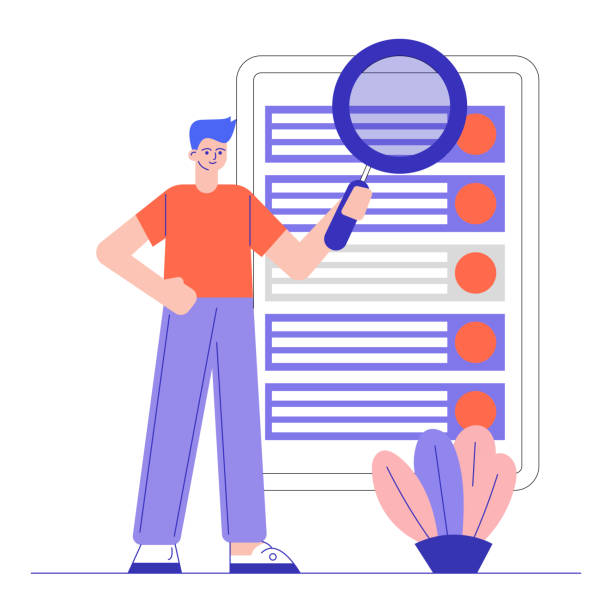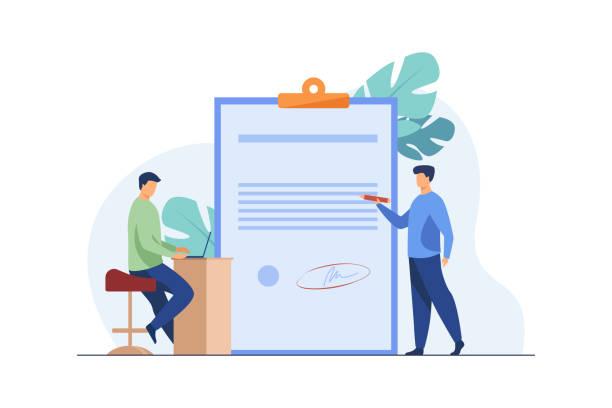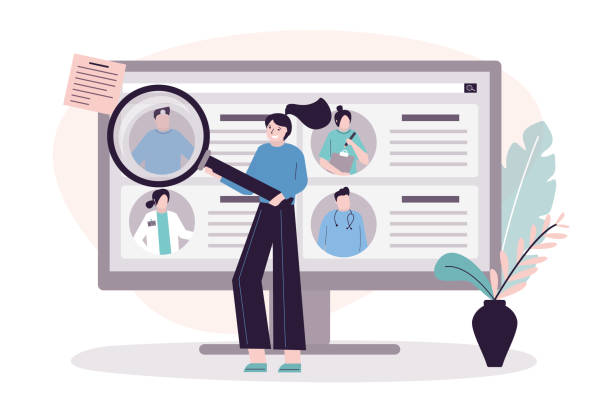Introduction to SEO-Optimized Website Design

In today’s digital world, merely having a website is not enough; your website needs to be seen.
This is where the concept of #SEO_Website_Design becomes important.
SEO-optimized website design means building a website that is not only attractive and functional for users but also understandable and appealing to search engines like Google, to achieve higher rankings in search results.
This is an explanatory and educational approach aimed at creating a strong foundation for your business’s online visibility.
The main goal of SEO-optimized website design is to increase your website’s visibility in organic search engine results.
This means attracting more free and targeted visitors, which can ultimately lead to increased sales and brand awareness.
A website designed from the ground up with an SEO approach reduces marketing costs in the long run and provides a better return on investment (ROI).
Numerous factors are involved in this area, including loading speed, mobile compatibility, URL structure, content quality, and user experience.
Ignoring any of these factors can harm your website’s ranking.
Therefore, any business seeking sustainable online success must consider SEO-optimized website design from the outset and view this process as a vital investment.
This investment not only means greater visibility but also building a solid foundation for the future growth and development of your business on the internet.
Did you know that poor online store design can drive away up to 70% of your potential customers? Rasaweb revolutionizes your sales with professional and user-friendly e-commerce website design.
✅ Significant increase in sales and revenue
✅ Full optimization for search engines and mobile
⚡ [Get Free Consultation from Rasaweb]
Key Principles of SEO-Optimized Website Design

To have an #SEO_Optimized_Website_Design, you need to be familiar with the principles of #On_Page_SEO, #Technical_SEO, and #Off_Page_SEO.
These three main pillars form the puzzle of search engine optimization.
On-page SEO involves optimizing internal website elements such as keywords, titles, meta descriptions, URL structure, and content.
This section requires a deep understanding of user behavior and search engine algorithms.
Technical SEO deals with the technical aspects of a website that directly affect its crawlability and indexability by search engine bots.
Factors such as site speed, mobile compatibility, code structure, robots.txt file, XML sitemap, and SSL usage fall into this category.
This is a completely specialized area that requires strong technical knowledge.
Finally, Off-page SEO refers to activities performed outside your website that influence its ranking, such as building quality backlinks, social media activity, and brand mentions on other websites.
An analytical and comprehensive approach to SEO-optimized website design means considering all three factors together, ensuring none is sacrificed for another.
A successful SEO-optimized website design is the result of balance and harmony among these three areas.
For example, even if your content is excellent (strong on-page SEO), but the site speed is low (weak technical SEO), user experience will suffer, and your ranking will drop.
Therefore, a comprehensive understanding and correct implementation of all three sections are crucial for achieving desired results in search engines.
This coordination between different SEO aspects paves the way for your website’s success in the competitive online space.
Fundamentals of Technical SEO in Design

Technical SEO is the heart of every #SEO_optimized_website_design.
In this section, we will explain and #guide you through the vital fundamentals that ensure search engines can properly find, read, and index your website.
Page Speed is one of the most important factors; users and search engines equally despise slow websites.
Tools like Google PageSpeed Insights can help you identify and fix speed issues.
Mobile compatibility and Responsive Design are also crucial, as a large portion of searches are done via mobile devices, and Google primarily indexes the mobile version of your site (Mobile-First Indexing).
Logical and hierarchical URL structure, using HTTPS for security (with an SSL Certificate), creating an XML sitemap, and a proper Robots.txt file to guide search engine crawlers are other vital technical SEO elements.
These elements help search engines better understand your content and display it in search results.
| Factor | Importance Explanation | Implementation Tips |
|---|---|---|
| Site Loading Speed | Direct impact on user experience and SEO ranking | Image optimization, caching, code compression |
| Mobile Compatibility (Responsive) | Essential for Mobile-First Indexing and mobile users | Use responsive design, test with Google tools |
| URL Structure and Internal Links | Helps search engines understand site structure and pass authority | Short and descriptive URLs, hierarchical structure |
| Security (HTTPS/SSL) | Google ranking factor and user trust | Install SSL certificate and redirect HTTP to HTTPS |
| XML Sitemap and Robots.txt | Guides search engines for crawling and indexing content | Regular creation and updates, submission to Search Console |
Paying attention to these details in SEO-optimized website design not only helps improve your ranking but also enhances user experience, which is itself an important SEO factor.
This educational and practical knowledge is the foundation of any successful website that aims to be seen in searches.
The Role of Content in SEO-Driven Design

After technical discussions, it’s time for #content, which is known as the king in the SEO world.
In an SEO-optimized website design, content plays a pivotal role.
Your content must not only be optimized for search engines but also fulfill users’ needs and answer their questions.
The first step is keyword research.
You need to understand what phrases your audience uses to search for your products or services.
Intelligent use of these keywords in titles, body text, and subtitles, without overdoing it or keyword stuffing, is crucial.
High-quality, comprehensive, and original content not only makes users spend more time on your site but also convinces search engines that your website is a reliable and authoritative source.
Content types can include educational articles, news posts, comprehensive guides, engaging, and entertaining content.
The more value your content provides to the user, the higher the likelihood of it being linked to and shared on social networks, which in turn helps improve the site’s off-page SEO.
In website optimization for search engines, special attention must also be paid to User Intent.
Is the user looking for information? Purchasing? Or comparing? Your content must align with this intent.
Using different content formats such as videos, infographics, and images can also enrich the user experience and assist SEO.
Although this section seemingly pertains only to content production, in reality, how this content is designed and displayed on the website, its layout, and its accessibility are all part of the SEO-optimized website design process.
Content that is well-structured and easy to read is more appealing not only to users but also to search engine crawlers.
Are you dissatisfied with low sales from your e-commerce site?
Rasaweb is your solution for a professional and high-selling e-commerce website.
✅ Significant increase in sales and revenue
✅ Easy and enjoyable shopping experience for customers
⚡ Get a free consultation from Rasaweb now!
The Connection Between User Experience (UX) and SEO

At first glance, #User_Experience (UX) and SEO might seem like separate domains, but in reality, there’s an unbreakable connection between them.
In an SEO-driven website design, UX plays a vital role.
Google and other search engines are increasingly emphasizing user experience-related factors for website ranking.
A website with good UX retains users for longer and has a lower Bounce Rate, which are positive signals for search engines.
UX factors affecting SEO include: ease of navigation, attractive visual design, text readability, page loading speed (as previously mentioned in the technical section), and site responsiveness (Responsive Design).
When users can easily find the information they are looking for and enjoy browsing the site, they are more likely to return to the site and recommend it to others.
These behaviors contribute to improving Dwell Time and reducing Bounce Rate, both of which are important metrics for Google.
A deep analysis shows that improving UX can directly lead to improved site SEO.
For example, designing a simple and intuitive navigation menu, using clear and appropriate headings (H1, H2, H3) to organize content, and ensuring that forms and buttons work correctly, all contribute to a better user experience and consequently stronger SEO.
Engaging or interactive content that involves users can increase dwell time.
Therefore, any investment in improving UX is essentially an investment in your SEO-optimized website design, and you will see its results in increased organic traffic and conversion rates.
Responsive Design and Mobile-First Priority

Given that most searches today are conducted via mobile, #Responsive_Design and #Mobile_Priority are of paramount importance in website design with an SEO approach.
Since 2018, with the introduction of Mobile-First Indexing, Google has explicitly stated that it primarily examines the mobile version of websites for ranking purposes.
This means that if your website does not display well on mobile or offers a poor user experience, even if its desktop version is excellent, your SEO ranking will suffer.
Responsive design means that your website automatically adapts to the user’s screen size (whether mobile, tablet, or desktop).
This includes adjusting image sizes, fonts, and the layout of page elements.
A responsive website requires less maintenance than having separate mobile and desktop versions and is also preferred from an SEO perspective.
This is an important news and specialized topic in SEO that is constantly changing and being updated.
To ensure your website is optimized for mobile, you can use free Google tools like the Mobile-Friendly Test.
This tool shows you whether your website is “Mobile-Friendly” according to Google and provides recommendations for improvement.
Ensuring this in SEO-optimized website design is not only crucial for your ranking but also directly impacts the experience of millions of mobile users and can significantly increase your conversion rate.
Failure to address this important factor can mean losing a large segment of potential audience.
Measuring Success and Analytical Tools

After implementing an #SEO_optimized_website_design, it’s crucial to be able to #measure and analyze its performance.
Without data analysis, you cannot understand what works and what needs improvement.
Web analytics tools such as Google Analytics and Google Search Console are essential.
Google Analytics provides you with precise information about user behavior on your site, including the number of visitors, pages viewed, time spent on site, bounce rate, and traffic sources.
Google Search Console provides information about your site’s performance in search results, including keywords through which users found your site, issues Google encountered while crawling and indexing your site, and internal and external links to your site.
These tools are invaluable guidance and educational resources for anyone looking to improve their site’s SEO.
| Tool/Metric | Description | Importance for SEO |
|---|---|---|
| Google Analytics | Tracking user behavior on site (visits, time, bounce rate) | Analyzing UX, conversion rates, and user engagement |
| Google Search Console | Monitoring site performance in search results (clicks, impressions, errors) | Identifying keyword opportunities, fixing technical errors |
| Bounce Rate | Percentage of users who visit only one page and leave | Indicates content and UX quality (lower is better) |
| Dwell Time | Amount of time a user stays on a page | Indicates content attractiveness and relevance (higher is better) |
| Keyword Ranking | Your site’s position for specific keywords in search results | Most important indicator for organic visibility |
By regularly using these tools and understanding relevant KPIs (Key Performance Indicators), you can create a continuous improvement cycle for your SEO-optimized website design and ensure that your SEO efforts are on the right track and will yield the necessary returns.
Common Mistakes in SEO-Optimized Website Design

On the path of #SEO_optimized_website_design, there are some common mistakes that can render your efforts fruitless.
One of the biggest errors is ignoring the importance of site speed.
A slow-loading website not only drives users away but is also penalized by search engines.
Also, lack of mobile compatibility is a major mistake, as Google strongly emphasizes Mobile-First Indexing, as previously mentioned.
Excessive use of keywords or Keyword Stuffing is another old mistake that not only doesn’t help but can also lead to site penalties by Google.
Duplicate or copied content from other sites is also detrimental to SEO and lowers your site’s credibility.
Broken Links also harm user experience and send negative signals to search engines.
Another mistake is neglecting proper internal linking.
Correct internal linking not only helps users navigate your site easily but also helps search engines understand your pages’ structure and hierarchy.
Failure to use appropriate heading tags (H1, H2, H3) and Meta Descriptions is also a common error that prevents search engines from correctly understanding and ranking your content.
This section is a specialized and explanatory guide to avoiding common pitfalls.
In SEO-optimized website design, every component must be carefully selected and implemented.
Avoiding these common mistakes will not only help you steer clear of search engine penalties but also lay the foundation for strong and sustainable SEO for your website.
Awareness of these SEO errors and preventing them is a crucial part of a successful optimization strategy.
Are you dissatisfied with the low conversion rate of visitors to customers on your e-commerce site?
Solve this problem forever with professional e-commerce website design by Rasaweb!
✅ Increase visitor-to-customer conversion rate
✅ Create an excellent user experience and build customer trust
⚡ Get a free consultation
Future Trends in SEO-Optimized Website Design

The world of SEO is constantly evolving, and to stay ahead, you must be aware of #future_trends.
#Artificial_Intelligence and Machine Learning are increasingly influencing how search engines work and rank websites.
Algorithms like BERT and RankBrain use AI to better understand user intent and content.
This means your content needs to be deeper, more comprehensive, and more natural.
Voice Search is also growing, and SEO-optimized website design should be optimized for these types of searches as well.
Voice queries are often longer and conversational, so focusing on Long-tail Keywords and direct answers to user questions becomes important.
The E-A-T (Expertise, Authoritativeness, Trustworthiness) factor is increasingly playing a role in Google’s evaluation of content and website quality, especially in sensitive areas like health and finance.
Semantic SEO is also on the rise.
Search engines no longer just look at individual keywords but pay attention to the relationships between words, concepts, and entities to understand the overall meaning of a page.
This is an analytical and news-oriented approach that helps you stay ahead in the competition.
For the future of SEO-optimized website design, focusing on quality, flawless user experience, and keeping pace with new technologies like AI will be essential.
These approaches will help you build a website that is at its peak not only today but also in the future.
Summary and Next Steps

In this article, we comprehensively examined the importance of #SEO_optimized_website_design and its key principles.
From technical fundamentals to the importance of content, user experience, mobile compatibility, and success measurement methods, all are part of a successful #SEO_strategy.
SEO-optimized website design is not a one-time process but requires continuous improvement and constant monitoring to keep pace with Google’s algorithm changes and user needs.
For sustainable success, after launching your website, you must continuously update your content, seek to build quality backlinks, and monitor your site’s performance using analytics tools.
Any investment in SEO-optimized website design will ultimately lead to increased organic traffic, improved search engine rankings, and consequently, increased sales and brand awareness.
This is a smart investment for the future of your online business.
If you encounter challenges at any stage or need specialized advice, you can seek help from SEO experts.
They can provide appropriate solutions for improvement with a precise analysis of your site’s current status.
Remember that success in SEO is a marathon, not a sprint.
With patience, continuous effort, and the right approach, your website can achieve the position it deserves.
This is a comprehensive guide for anyone who wants to succeed in the digital world, and it’s entertaining to see the results of your work at the top of search results.
Frequently Asked Questions
| Question | Answer |
|---|---|
| What is SEO-optimized website design? | Designing a website that is optimized for both users and search engines to achieve higher rankings. This includes adhering to technical, content, and user experience principles. |
| Why is SEO important in website design? | SEO’s importance in website design is due to its ability to increase site visibility in search results, attract organic traffic, improve user experience, and enhance credibility and user trust. |
| What are the most important elements of SEO-friendly website design? | Responsiveness for mobile, high loading speed, clear navigation structure, correct use of heading tags (H1-H6), image optimization, and quality content. |
| What is the impact of responsiveness (mobile-friendliness) on SEO? | Google uses mobile-first indexing, meaning it prioritizes the mobile version of websites for ranking. Therefore, responsiveness is vital for SEO. |
| What is the role of site speed in SEO? | Faster websites offer a better user experience, reduce bounce rates, and are favored by search engines. Site speed is one of Google’s ranking factors. |
| How to optimize images for SEO? | By compressing image file sizes, using descriptive and relevant file names, and most importantly, writing appropriate and content/keyword-relevant Alt Text. |
| What is the importance of content in SEO-driven design? | High-quality, relevant, and keyword-rich content is crucial for attracting and engaging users, as well as for ranking in search engines. Content is the king of SEO. |
| How does URL structure affect SEO? | Clean, descriptive, short URLs containing keywords help users and search engines better understand page content and appear in search results. |
| What is Schema Markup and what is its role in SEO? | Schema Markup is structured data that helps search engines better understand website content and display it as Rich Snippets in search results, which increases the click-through rate (CTR). |
| Should SEO be considered from the beginning of website design? | Yes, it is highly recommended. Integrating SEO principles from the initial phase of website design saves time and cost, and leads to better and more sustainable long-term results. |
And other services of Rasaweb Advertising Agency in the field of advertising
Smart Direct Marketing: An effective tool for increasing sales with the help of marketing automation.
Smart Social Media: Professional optimization to increase click-through rates using precise audience targeting.
Smart Marketplace: Designed for businesses seeking digital branding through intelligent data analysis.
Smart Digital Advertising: Revolutionize click-through rate increase with Google Ads management.
Smart UI/UX: A professional solution to boost sales by focusing on attractive user interface design.
And over hundreds of other services in the fields of internet advertising, advertising consulting, and organizational solutions
Internet Advertising | Advertising Strategy | Advertorial
Resources
Source 1: SEO-Related ArticleSource 2: Web Design Tips BlogSource 3: Online Success GuideSource 4: Search Engine Optimization Portal
? Are you ready to revolutionize your business in the digital world?
With Rasaweb Afarin Digital Marketing Agency, you no longer have to worry about your business not being seen. With our expertise in areas such as WordPress website design, Search Engine Optimization (SEO), and comprehensive digital marketing strategies, we build a strong bridge between you and your customers.
Contact us today for a free consultation and secure your business’s digital future!
📍 Tehran, Mirdamad Street, Next to Central Bank, Southern Kazeroun Alley, Ramin Alley No. 6


